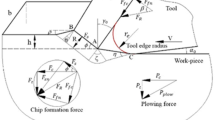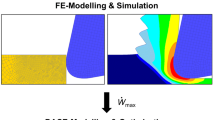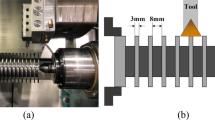Abstract
The high-speed and high-efficient cutting is the future of the mechanical processing technology. The tool edge preparation prolongs the service life of the tool, elevates the machined surface quality and the cutting performance through modification of the cutting edge contour, micro-topography and microstructure in the edge area. It is necessary to study the edge preparation mechanism to realize the importance of the high-speed and high-efficiency cutting. The mathematical model of the milling tool motion trajectory is built up using the edge preparation characteristics of the planetary motion. Based on the basic principle of the discrete element method and the Hertz contact theory, the simulation model of the tool edge preparation process is set up through the discrete element software EDEM. The effects of the speed, the preparation time, the abrasive mesh, the abrasive ratio, the rotation direction on the abrasive state, the abrasive velocity, the cumulated energy, the wear and the action force are investigated. In this paper, the basis for the edge preparation optimization is provided and the importance of the high-speed and high-efficiency machining is highlighted.




















Similar content being viewed by others
References
Uhlmann E, Oberschmidt D, Kuche Y (2014) Cutting edge preparation of micro milling tools. Procedia CIRP 14:349–354
Barletta M, Gisario A, Venettacci S et al (2014) A comparative evaluation of fluidized bed assisted drag finishing and centrifugal disk dry finishing. Eng Sci Technol Int J 17(2):63–72
Sooraj VS, Radhakrishnan V (2014) A study on fine finishing of hard workpiece surfaces using fluidized elastic abrasives. Int J Adv Manuf Technol 73(9–12):1495–1509
Biermanna D, Aßmutha R, Hessa S, Tiffea M (2018) Simulation based analysis and optimisation of the cutting edge micro shape for machining of nickel-base alloys. Procedia CIRP 67:284–289
Bergmann B, Grove T (2018) Basic principles for the design of cutting edge roudings. CIRP Ann Manuf Technol 67:73–7874
Khana SA, Umara M, Saleem MQ (2018) Experimental investigations on wiper inserts’ edge preparation, workpiece hardness and operating parameters in hard turning of AISI D2 steel. J Manuf Process 34:187–196
Krebs E, Wolf M, Biermann D (2018) High-quality cutting edge preparation of micromilling tools using wet abrasive jet machining process. Prod Eng Res Dev 12(1):45–51
Tiffe M, Aßmuth R, Saelzer J et al (2019) Investigation on cutting edge preparation and FEM assisted optimization of the cutting edge micro shape for machining of nickel-base alloy. Prod Eng 13:459–467
Uhlmann E, Eulitz A, Dethlefs A (2015) Discrete element modelling of drag finishing. Procedia CIRP 31:369–374
Hou YJ, Wang JS, Li AF et al (2014) Discrete element method and its application in bucket design. Eng Mach 45(4):23–29
Pan SQ, Cao ZF, Yang YL et al (2016) The core-type opener design based on DEM. Agric Mech Res 9:23–27
Liao QX, Zhang PL, Liao YT et al (2014) A numerical simulation of the centrifugal type seeding performance based on EDEM. Trans Chin Soc Agric 45(2):109–114
Zhao XF, Du YC, He L, Tao M (2019) Influence of edge, preparation of coated carbide tool on milling aluminum alloy 211Z. J Braz Soc Mech Sci Eng 41(2):109
Gui CL (1990) The wear design calculation model of Archard and its application method. Lubr Eng 1:12–21
Acknowledgements
The authors would like to acknowledge the financial support provided by National Natural Science Foundation Project (No. 51665007) and the Research Fund of High-level innovative Talents Project in Guizhou Province (Grant No. [2016]4033).
Author information
Authors and Affiliations
Corresponding author
Additional information
Technical Editor: Lincoln Cardoso Brandao.
Publisher's Note
Springer Nature remains neutral with regard to jurisdictional claims in published maps and institutional affiliations.
Rights and permissions
About this article
Cite this article
Zhao, X., Zheng, P., He, L. et al. Cutting edge preparation using the discrete element software EDEM. J Braz. Soc. Mech. Sci. Eng. 42, 163 (2020). https://doi.org/10.1007/s40430-020-2250-5
Received:
Accepted:
Published:
DOI: https://doi.org/10.1007/s40430-020-2250-5




